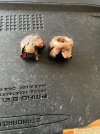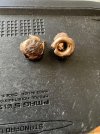More bullets added to my ever growing database.
One of these is from a small custom bullet maker, J&A Custom Ammunition, called the Abram. They seem to be a great compromise between a soft point design, that would lower potential BC and consistency, and your typical open tip match (OTM) bullet. The open tip on the Abram is larger than most every OTM style bullet out there, but the lead core goes almost all the way to the opening. This allows a more controlled (less dramatic) expansion upon impact, but still reliably expands thanks to the thin jacket.
There are other OTM style bullets, such as the Berger Hybrid varieties, that take a different approach. They feature a smaller opening, but a large cavity below the opening. Sometimes a huge cavity can create expansion that initiates rapidily and dramatically, often resulting in over-expansion. The Berger Hybrids feature ribs/flutes (whatever you want to call them) right at the ogive where the cavity is. This allows the expansion to be less dramatic, but still reliable. Just some food for thought there. I know the Abram went through some testing with cavity size and this bullet pictured below is the design that proved most reliable and effective.
The Abram has very concentric and relatively thin jackets too. This will mean great expansion still at lower impact velocities, but also requires sufficient sectional density to be taken into consideration with shots that would be at higher impact velocities. I'd recommend going with a version no lower than .260, but ideally not lower than .280 if impact velocities will be above 2400-2600fps. The 213gr version below has an SD of .321, for what that's worth. The Abram should be good down to at least 1600fps impact velocity, and perhaps more with sufficient reliability testing to prove or dispute that theory.
The other bullets are some options from Norma. The Tipstrike is what I view as their version of a Hornady ELDX, and also similar to a Nosler Ballistic Tip (similar shaped base and jacket tapering). It has a very short boat tail, which is more or less just a rounded edge, so the aerodynamics and BC won't be as high as a similar weight and diameter ELDX.
The Tipstrike is not bonded, but does feature an interlock ring near the base. This is done in an effort to keep the jacket and core from completely separating as the bullet expands and sheds weight upon impact. Being so far down on the bullet, it won't stop expansion as much as other bullets that have the intetlock rings more towards the middle of the bullet. The jackets on the Tipstrike are quite thick, however, and that'll greatly reduce the ability for expansion at lower impact velocities, even though they taper out thinner at the ogive. Like the ELDX, they'll still expand well at the ogive when dipping into lower impact velocities, but the base will not expand well at lower velocities and that type of performance relies heavily on shot placement and luck. I wouldn't feel confident using this bullet below an impact velocity of 1800fps.
The blue tipped bullet is the Norma Bondstrike. It has a more traditional sized boat tail, which will aid in efficiency in flight and should help retain more velocity, resulting in a higher impact velocity compared to the same weight and same MV Tipstrike, but this is actually a fully bonded bullet, and also has a pretty thick jacket. The rate of expansion with this bullet is going to be much slower than even the Tipstrike, or an Abram, ELDM, TMK, etc. This bullet will do best impacting at high velocities. It would be something that works best fired from a fast pushing magnum cartridge and at close to medium distances. I wouldn't be confident using it below 2000fps, and it may even be best to keep it above 2200fps. So, it's good that it will retain more velocity because it'll need it.
Edit: here's some links to similar threads of mine for those that may be interested:
https://www.longrangehunting.com/threads/eldm-vs-eldx-construction-wise.312650/
https://www.longrangehunting.com/threads/sierra-tmk-vs-tgk-gamechanger.312653/
https://www.longrangehunting.com/threads/bullet-construction.283735/









One of these is from a small custom bullet maker, J&A Custom Ammunition, called the Abram. They seem to be a great compromise between a soft point design, that would lower potential BC and consistency, and your typical open tip match (OTM) bullet. The open tip on the Abram is larger than most every OTM style bullet out there, but the lead core goes almost all the way to the opening. This allows a more controlled (less dramatic) expansion upon impact, but still reliably expands thanks to the thin jacket.
There are other OTM style bullets, such as the Berger Hybrid varieties, that take a different approach. They feature a smaller opening, but a large cavity below the opening. Sometimes a huge cavity can create expansion that initiates rapidily and dramatically, often resulting in over-expansion. The Berger Hybrids feature ribs/flutes (whatever you want to call them) right at the ogive where the cavity is. This allows the expansion to be less dramatic, but still reliable. Just some food for thought there. I know the Abram went through some testing with cavity size and this bullet pictured below is the design that proved most reliable and effective.
The Abram has very concentric and relatively thin jackets too. This will mean great expansion still at lower impact velocities, but also requires sufficient sectional density to be taken into consideration with shots that would be at higher impact velocities. I'd recommend going with a version no lower than .260, but ideally not lower than .280 if impact velocities will be above 2400-2600fps. The 213gr version below has an SD of .321, for what that's worth. The Abram should be good down to at least 1600fps impact velocity, and perhaps more with sufficient reliability testing to prove or dispute that theory.
The other bullets are some options from Norma. The Tipstrike is what I view as their version of a Hornady ELDX, and also similar to a Nosler Ballistic Tip (similar shaped base and jacket tapering). It has a very short boat tail, which is more or less just a rounded edge, so the aerodynamics and BC won't be as high as a similar weight and diameter ELDX.
The Tipstrike is not bonded, but does feature an interlock ring near the base. This is done in an effort to keep the jacket and core from completely separating as the bullet expands and sheds weight upon impact. Being so far down on the bullet, it won't stop expansion as much as other bullets that have the intetlock rings more towards the middle of the bullet. The jackets on the Tipstrike are quite thick, however, and that'll greatly reduce the ability for expansion at lower impact velocities, even though they taper out thinner at the ogive. Like the ELDX, they'll still expand well at the ogive when dipping into lower impact velocities, but the base will not expand well at lower velocities and that type of performance relies heavily on shot placement and luck. I wouldn't feel confident using this bullet below an impact velocity of 1800fps.
The blue tipped bullet is the Norma Bondstrike. It has a more traditional sized boat tail, which will aid in efficiency in flight and should help retain more velocity, resulting in a higher impact velocity compared to the same weight and same MV Tipstrike, but this is actually a fully bonded bullet, and also has a pretty thick jacket. The rate of expansion with this bullet is going to be much slower than even the Tipstrike, or an Abram, ELDM, TMK, etc. This bullet will do best impacting at high velocities. It would be something that works best fired from a fast pushing magnum cartridge and at close to medium distances. I wouldn't be confident using it below 2000fps, and it may even be best to keep it above 2200fps. So, it's good that it will retain more velocity because it'll need it.
Edit: here's some links to similar threads of mine for those that may be interested:
https://www.longrangehunting.com/threads/eldm-vs-eldx-construction-wise.312650/
https://www.longrangehunting.com/threads/sierra-tmk-vs-tgk-gamechanger.312653/
https://www.longrangehunting.com/threads/bullet-construction.283735/
Last edited:


